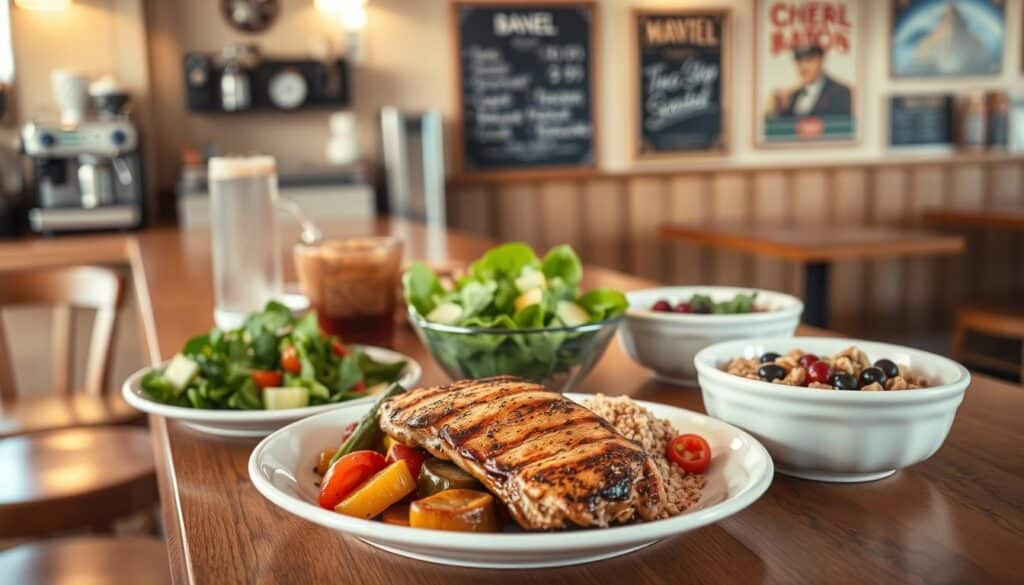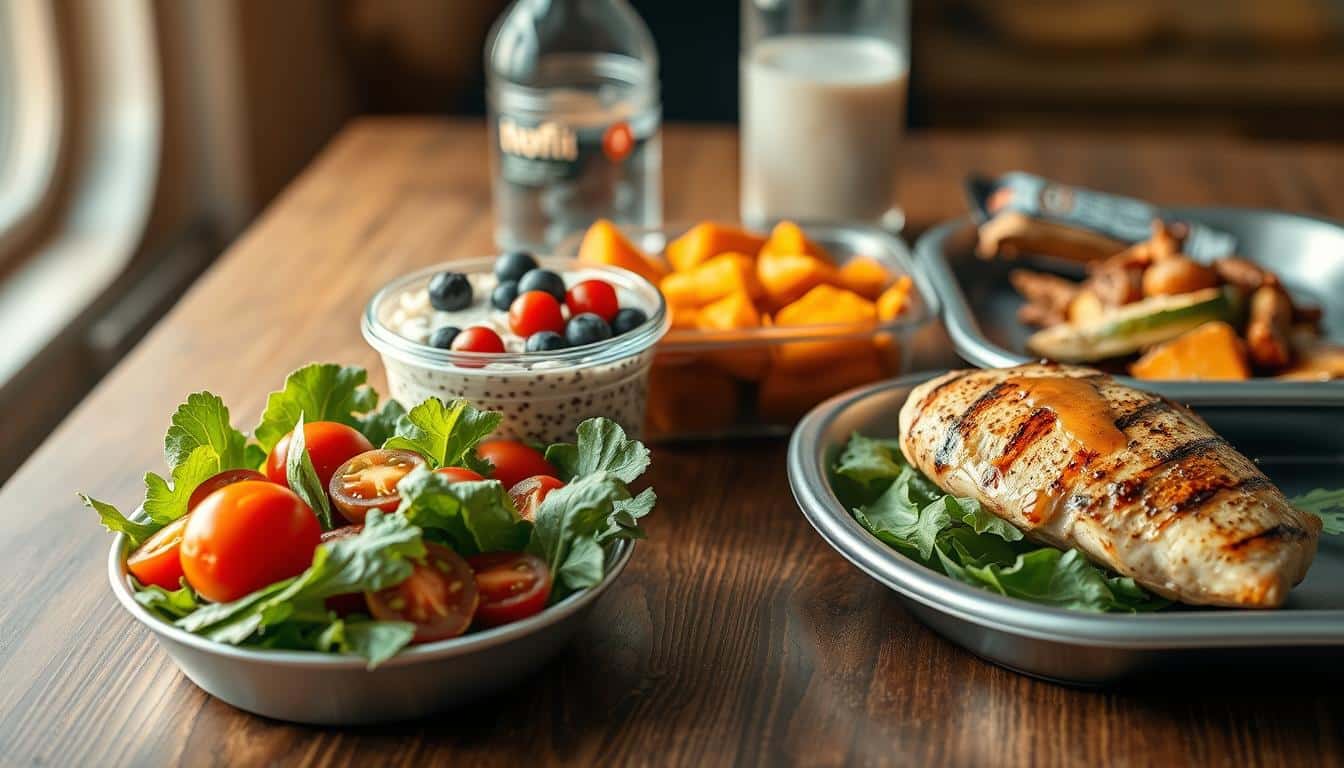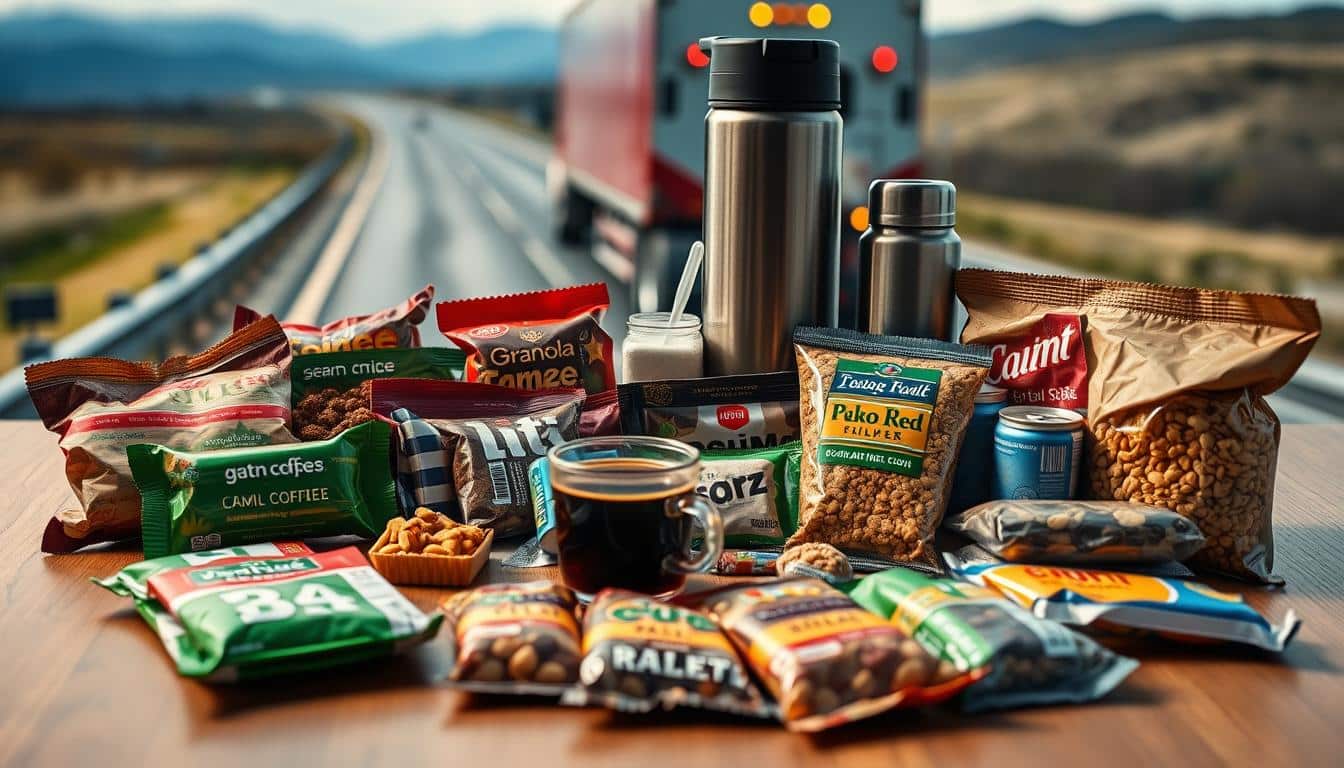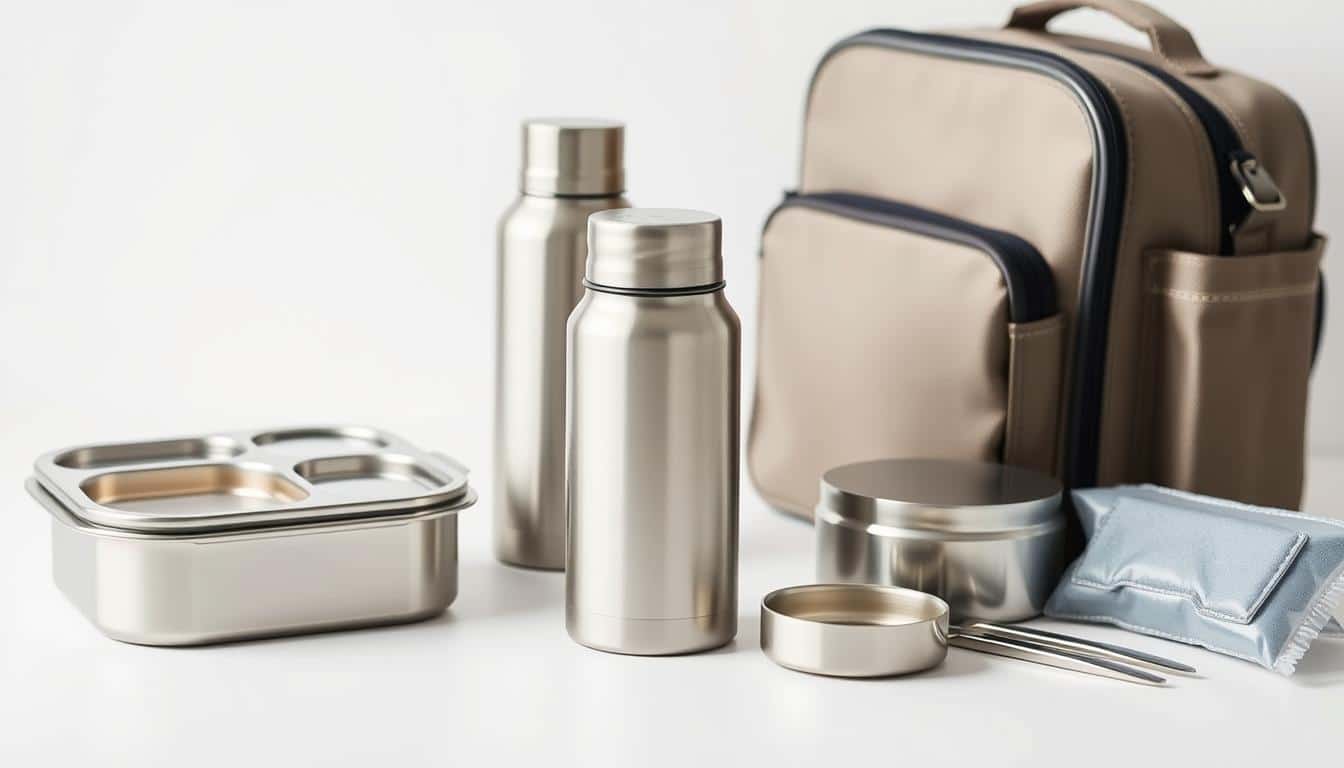This guide gives practical and flavorful ideas for drivers cooking in small spaces. It’s perfect for those running regional routes or crossing the country. These easy truck stop recipes and cab cooking tips will help you eat well without spending too much time or money.
These trucker meals and recipes reduce costs at truck stops. They also help you control calories, sodium, and fat, keeping you alert on long drives. Websites like Taste of Home and Dashing Dish show how to make street-food favorites in your cab. Think hot dogs, sliders, walking tacos, and microwave risotto.
Road Legends and Drive My Way talk about planning and using small appliances. Items like 12-volt fridges and microwave-safe meal prep gear are key. You’ll find tips for quick breakfasts, lunches, dinners, snacks, and healthier versions of indulgent snacks. Plus, there are storage and prep hacks for a single cab.
We’ve got simple recipes, grocery lists, and equipment ideas to make eating on the road easy, tasty, and safe. Expect tips for making mug omelets, jar salads, microwave dinners, and portioned snacks. There are also smarter versions of classic truck-stop treats to enjoy.
Why truck-friendly meals matter for drivers
Eating well on the road is essential for health, staying alert, and ensuring safety. Truck stop food often has too many calories, fat, and salt. Making your own food lets you choose what goes into your meals. This helps you avoid feeling tired and keeps you focused while driving.
Health, alertness, and safety on the road
Meals with a good mix of protein, fiber, and carbs help avoid low blood sugar. Low blood sugar can make you feel sleepy. Drinking enough water and picking the right snacks can help you stay sharp. Choosing healthy foods helps reduce the risk of accidents by keeping your energy levels steady.
Cost and time savings versus frequent truck stop purchases
Eating at truck stops can become expensive quickly. Planning your meals ahead of time can turn costly stops into rare indulgences. Preparing simple meals for breakfast, lunch, and snacks saves money. It also keeps meals tasty and nutritious.
Limited equipment, big flavor strategies
Cooking in a small cab is easier with the right tools and strong flavors. A small cooler, a portable cooker, or a thermos can offer more meal options. Adding marinades, spicy sauces, and seasoning mixes can make even small dishes delicious.
- Pack proteins that store well, like canned tuna, Greek yogurt, or pre-cooked chicken.
- Choose fiber-rich staples such as whole-grain wraps, apples, and baby carrots.
- Keep single-serve condiments and a small bottle of olive oil to enhance flavors without extra work.
Having the right approach—using a small space well and focusing on flavor—makes cooking in a cab both possible and fun. Careful meal planning is good for your health, saves money, and keeps you safe on the road.
easy truck stop recipes for breakfast that fuel long hauls
Start your day right with quick, on-the-go breakfasts. They’re designed to boost your energy during long drives. These meals are rich in protein and fiber but easy to prepare. You’ll stay awake and full, using just a little cooler, a microwave, or nothing at all!
Mug omelet and breakfast burrito options
Making a mug omelet is fast and perfect for a quick start. Just whisk two eggs in a mug that’s safe for the microwave. Add in spinach, peppers, some cheddar, and your choice of turkey or ham. Cook it in the microwave until it’s done.
For an easy breakfast burrito, just wrap your omelet in a tortilla. You can make a bunch, then keep them in the fridge or freezer. Whenever you’re ready, warm one up in the microwave at any truck stop for a quick and tasty meal.
Make-ahead egg bakes and boiled eggs
Try a make-ahead egg bake with whatever veggies, cheese, and meat you have leftover. Cook it in a big pan, cut it into pieces, and keep it cool. You can have slices hot or cold, maybe with some fruit on the side.
Hard-boiled eggs are great for a no-fuss snack. They’re packed with protein and easy to munch on the go. Opt for less salt in your egg bake and add veggies for extra health benefits.
Portable fruit, muffins, and energy bars
Eggs and fresh fruits like apples or bananas make a good combo. Try a microwave blueberry muffin with oats for a fiber boost. It’s good for when you’re in a hurry.
Pack homemade or low-sugar bars for steady energy while driving. Mixing muffins, fruits, and bars helps keep things interesting. This saves you from buying on impulse and keeps breakfast fun each day.
Quick lunch ideas truckers can prepare in minutes
Short stops don’t have to mean boring meals. Drivers can make fresh, tasty lunches that are better than fast food. Simply pack a cooler, prepare ingredients ahead, and change toppings for new flavors.
Jar salads and protein bowls
Mason jars keep salads fresh. Start with your dressing at the bottom. Then add hardy veggies, and grains like quinoa. Finish with protein on top, such as chicken or beans. This keeps your salad fresh for days.
Protein bowls can be hot or cold. Use grains, veggies, and proteins like tofu. Different sauces can add new tastes without having to shop more.
Sandwich, wrap, and lettuce-wrap alternatives
For quick eats, try sandwiches and wraps. Think about using ciabatta with tomato-avocado-mozzarella. Or, wrap turkey with spinach and hummus. Don’t forget veggie burgers in whole-grain wraps.
Lettuce wraps are great for cutting carbs and staying cool. Fill romaine with chicken or turkey. Pre-slice ingredients for easy grabbing.
Walking tacos and ready-to-eat protein packs
Make walking tacos with a chip bag. Add beef or beans, cheese, and pico de gallo. It’s a quick, customizable snack.
For snacks, keep protein packs ready. Combine eggs, nuts, jerky, cheese, and crackers. They help you avoid junk food and stay energized.
- Tip: Pre-portion dressings in small containers to avoid soggy greens.
- Tip: Use insulated lunch bags or coolers to keep dairy and meat safe.
- Tip: Rotate proteins and grains weekly to keep trucker lunch recipes interesting.
Microwave-friendly dinners and one-cab meals
After a long day, simple, homey dinners are a must. Truck drivers can lean on easy staples to transform small cab spaces into good meal spots. Choose dishes that are warm, full of protein, easy to store, quick to heat up, and low on salt.
Thermos meals are perfect for soups and chili. A good stainless thermos can keep chili or veggie soup hot for many hours. This is handy when it’s a long time till the next stop. Road Legends suggests using lean meat, beans, and lots of veggies to stay full and energized.
At truck stops, pour your soup into a microwavable bowl. Heat it up for 60 seconds at a time and stir well. Bring low-sodium broth and your own spices to keep it tasty without too much salt.
Microwave risotto, spaghetti squash, and quick pasta alternatives
Microwave risotto is creamy and easy to make. Use quick-cook rice and add mushrooms and parmesan to finish in less than 10 minutes. It’s a tastier choice than instant noodles.
Try spaghetti squash instead of pasta. Cook it in the microwave, shred it, and add sauce, chicken, or beans. You can also heat up whole-grain pasta or grains quickly in the microwave.
Slow cooker dinners and overnight prep
A slow cooker makes a big difference in a truck cab. Use a 12-volt or compact cooker to create dishes like pulled pork or chicken tacos. These can be made in advance and taste great as leftovers, according to Taste of Home and Road Legends.
Get meals ready the night before and put them in microwavable containers. Write the date and how to heat them up on each one. This trick saves time after working all day and cuts down on spending at truck stops.
- Pack thermos meals for long drives and microwave containers for quick stops.
- Use low-salt broths and sauces to control your salt intake.
- Mix microwave meals with fresh veggies and precooked meats for a healthy balance.
- If you have time overnight, consider using a slow cooker in your truck cab.
Snack strategies to avoid unhealthy truck stop temptations
Smart snacking keeps your energy up and stops the late-night rush for fast food. Pack snacks that are crunchy, creamy, and full of protein to keep hunger away. A few simple steps can make choosing healthy snacks on the go really easy.
-
Portion-controlled snacks and pre-bagging
Packing snacks ahead stops you from overeating. Use small bags or containers to split nuts, trail mix, popcorn, and chips. This makes it easy for drivers to control portions and track calories.
-
Vegetable packs and easy salads
Make veggie snack packs with carrots, celery, cherry tomatoes, cucumber, and broccoli. Add hummus or Greek yogurt dip for extra flavor. Simple salads or mason-jar salads are great for travel. They’re healthier than candy aisles.
-
High-protein grab-and-go choices
Have hard-boiled eggs, cheese sticks, beef jerky, and protein packs close by. They help you feel full and keep your blood sugar stable. Companies like Hormel and Sabra make these snacks perfect for the road.
-
Healthy substitutes and sweet fixes
Instead of candy, try frozen fruit bars, frozen grapes, or sweet potato chips. Air-popped popcorn and dried fruit can satisfy your sweet craving with less sugar. These options help with portion control and keep you away from truck stop snacks.
-
Storage and safety tips
Keep snacks fresh in a 12-volt fridge or a cooler. Remember to rotate them, use airtight containers, and label with dates. This helps extend the life of your veggie packs and other healthy snacks.
Easy and indulgent truck stop-style recipes made healthier
Truck stop food can be both comforting and healthy. Swap frying for baking, choose lean meats, use reduced-fat cheese, and pick whole-grain wraps. These small changes keep the taste but make the food better for you. Perfect for long drives.

Make corndogs without frying. Use lean or vegetarian hot dogs. Coat them in a light batter, then bake or air-fry. Serve with carrots or a little slaw to make it a balanced meal.
- Healthy sliders: Use lean meat or black beans for small patties. Add them to whole-wheat buns and top with low-fat cheese and pickled onions.
- Lighter loaded fries: Choose baked sweet potato wedges or air-fried potatoes instead of regular fries. Add a bit of cheddar, Greek yogurt, and cabbage for taste without guilt.
Fish tacos are great for travel if you avoid frying. Use oven-baked or air-fried fish in whole-grain wraps or lettuce. Add a slaw with lime and a bit of yogurt to keep things light yet tasty.
Chicken souvlaki and rib alternatives can be made with a slow cooker or grill. Marinate chicken with lemon and oregano for easy meals. Choose vinegar-based BBQ sauce for ribs to reduce sugar. Put single servings in containers for easy heating on the go.
- Small changes like choosing less sugar and more vegetables make meals healthier but still indulgent. This lowers sodium and bad fats.
- Look for recipes from reliable sources like Taste of Home. They offer methods that taste great but cut calories.
For dessert, go for fruit-based options. Try frozen banana pops, orange ice pops, or berries with a bit of whipped topping. These choices help you stick to healthier recipes while enjoying the journey.
Meal prep and storage hacks for the cab
Smart cab meal prep helps save time, money, and reduces stress on long trips. It starts with a few reliable tools and a simple plan. It’s important to keep perishable food cold, hot meals hot, and snacks within easy reach.
Using a cooler, 12-volt fridge, and insulated containers
Consider a quality 12-volt fridge for trucks for constant cooling on long journeys. Brands like Dometic or RoadPro have portable models that fit many sleeper spaces. They keep dairy, pre-cooked proteins, and salads safe below 40°F.
Combine the fridge with a strong cooler and top-notch ice packs for weekends away. Insulated thermos meals can keep your breakfast or soup hot for hours, which means less time reheating.
Batch cooking, portioning, and labeling
Batch cooking means preparing meals just once and eating well all week. Use slow cookers or set aside weekend time for big meals like stews, chili, and grain bowls.
Divide the meals into microwave-safe containers, add a label with the date and contents, and use older items first. Begin small: prep only one meal or for a single day. Then, you can build up to a full week’s routine.
Cooking gadgets that make life easier
Select small cooking gadgets that fit your space and follow cab rules. Items like electric kettles, single-serve slow cookers, and immersion blenders save space. A tiny air fryer or mug-microwave accessories can make omelets, muffins, and quick risotto easily.
Store utensils, condiments, and disposable plates in labeled bins to save time on stops. A clean cab makes cooking on the go quicker and safer.
- Food safety tip: keep cold items below 40°F, pre-cook proteins, and discard anything left too long.
- Organization tip: keep condiments and snacks in clear bins for easy access during breaks.
- Start-up tip: try insulated thermos meals for a day before upgrading to a full 12-volt fridge setup.
Time-saving grocery lists and pantry staples for drivers
Packing smart makes meals quick, affordable, and healthier on the road. Stick to a simple trucker grocery list. It should balance non-perishable goods with some cooler items. Choose ingredients that can be used for all meals and snacks for the best value.

High-impact staples to keep on hand
Begin with pantry essentials for truckers that go a long way. Think canned beans, canned tuna, pre-cooked rice or quinoa, instant oats, and whole-grain tortillas. Include nut butter, mixed nuts, trail mix, popcorn, and shelf-stable milk for energy and snacks.
- Canned beans and broths for quick stews and protein-packed dishes.
- Tuna and precooked grains make 5-minute lunches easy.
- Instant oats and tortillas offer versatile breakfast options.
Perishable items worth the cooler space
Pick perishable items that pack a nutritional punch per cooler space. Eggs, Greek yogurt, cheese sticks, pre-cooked chicken, and lean deli meats offer easy protein. Fresh fruit and pre-cut veggies bring fiber and vitamins.
- Boiled eggs or carton eggs for easy omelets and snacks.
- Greek yogurt works great for breakfasts, smoothies, or dips.
- Pre-cooked chicken and low-sodium deli meats are perfect for wraps and salads.
Seasonings, sauces, and condiments to boost flavor
Small jars and squeeze bottles of condiments save space and add taste. Stock up on salt-free seasonings, black pepper, garlic powder, and chili powder. Low-sodium soy sauce is a must. A few favorite toppings can turn simple meals into road trip delights.
- Hot sauce, mustard, and salsa add instant flavor.
- Olive oil and small bottles of vinegar or citrus juice are great for dressings.
- BBQ sauce or a soy-ginger mix can recreate diner meals.
Smart shopping tips
Choose items that can be used in multiple recipes. Opt for lower-sodium versions of packaged foods where possible. This approach to shopping saves money and keeps meals tasty during long trips.
Conclusion
Easy truck stop recipes are a win-win. They help drivers save money, eat healthier, and stay focused while driving. With these meals, drivers spend less time stopping and more time driving.
Begin meal prep with a simple plan. Choose one breakfast and one dinner for the week. Don’t forget to pre-portion snacks. Keep your grocery list short, focusing on essentials and fresh items. Tools like a 12-volt cooler or a compact cooker make cooking easy on the road. This guide offers recipes that are easy and tasty.
Cooking in your truck can become a normal part of life. You only need a few basics and some good recipes for quick meals. Resources like Taste of Home and Dashing Dish provide great ideas. They help make meals that are not only quick but also delicious and safe for on-the-go lifestyles.
FAQ
What equipment do I really need to cook safely in a truck cab?
How can I save money and time while still eating well on the road?
What are quick, filling breakfast ideas that don’t require much space?
Which dinners work best when I only have a microwave or a thermos?
How do I keep perishable foods safe without a full refrigerator?
Can I recreate truck-stop favorites in a healthier way?
What snacks best help maintain alertness while driving?
How should I organize meal prep and storage to make eating easy on shifts?
What pantry staples should every driver keep on hand?
Are mug and microwave recipes really filling enough for long hauls?
How can I keep indulgent cravings under control without feeling deprived?
What are safe, microwave‑friendly protein options that travel well?
How do I balance sodium and calories when adapting recipes for the cab?
Which cooking gadgets make the most difference in a small cab kitchen?
How do I start meal prepping if I’m new to cooking on the road?
Content created with the help of Artificial Intelligence.



